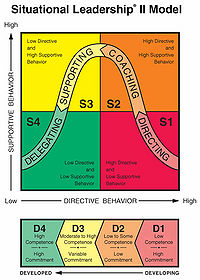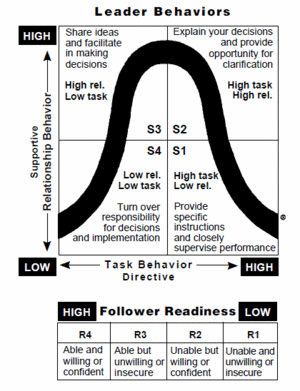Situational Leadership II
(→Case Study: Situational Leadership Style as a Predictor of Success and Productivity Among Taiwanese Business Organizations) |
|||
| Line 1: | Line 1: | ||
In an organizational environment project managers are challenged to face different circumstances every different day, in order to achieve this they need to adapt continually new managerial roles. The fundamental skills that a project manager should have are divided into six categories: communication, organizational, team building, leadership, coping, and technological skills. <ref name="project”> R Meredith, B.Z Posner, S.J.Jr Mantel Project management: a managerial approach, John Wiley, New York (1995) </ref>. | In an organizational environment project managers are challenged to face different circumstances every different day, in order to achieve this they need to adapt continually new managerial roles. The fundamental skills that a project manager should have are divided into six categories: communication, organizational, team building, leadership, coping, and technological skills. <ref name="project”> R Meredith, B.Z Posner, S.J.Jr Mantel Project management: a managerial approach, John Wiley, New York (1995) </ref>. | ||
| − | Most engineers are positioned as project managers based on their technical ranks <ref name="project”> DiMarco, N. J., Goodson, J. R., & Houser, H. F. (1989). Situational leadership in a project/matrix environment. Project Management Journal, 20(1), 11–18. </ref>, regardless of the project management training that they have. | + | Most engineers are positioned as project managers based on their technical ranks <ref name="project”> DiMarco, N. J., Goodson, J. R., & Houser, H. F. (1989). Situational leadership in a project/matrix environment. Project Management Journal, 20(1), pp. 11–18. </ref>, regardless of the project management training that they have. |
The roles of project manager should be adjusted by taking into consideration the specific project and environmental situation. <ref name="project”> Dilworth, J.B., R.C. Ford, P.M. Ginter, A.C. Rucks, “Centralized Project Management,” Journal of Systems Management, August, 1985, pp. 30-35. </ref>. The situational-specific approach to leadership/management is considering as the most efficient way to manage or supervise different environment and functions. | The roles of project manager should be adjusted by taking into consideration the specific project and environmental situation. <ref name="project”> Dilworth, J.B., R.C. Ford, P.M. Ginter, A.C. Rucks, “Centralized Project Management,” Journal of Systems Management, August, 1985, pp. 30-35. </ref>. The situational-specific approach to leadership/management is considering as the most efficient way to manage or supervise different environment and functions. | ||
Revision as of 12:22, 24 September 2017
In an organizational environment project managers are challenged to face different circumstances every different day, in order to achieve this they need to adapt continually new managerial roles. The fundamental skills that a project manager should have are divided into six categories: communication, organizational, team building, leadership, coping, and technological skills. [1]. Most engineers are positioned as project managers based on their technical ranks [2], regardless of the project management training that they have.
The roles of project manager should be adjusted by taking into consideration the specific project and environmental situation. [3]. The situational-specific approach to leadership/management is considering as the most efficient way to manage or supervise different environment and functions. Situational leadership can help engineers become successful managers and enable them diagnose their working environment.
Contents |
Application of Situational Leadership II in Management
The Situational Leadership theory introduced by Paul Hersey and Kenneth H. Blanchard (1974,1982). The revised model Situational Leadership II was published in January-March 1985 [4]. The idea behind it, is that the most effective leadership style is situational-specific. They argued that when the situation is changing (people involved in the project), the leadership style that it is applicable will have differences from the the one used efficiently before (Ronald K. Hambleton and Ray Gumpert, 1982).
The management concept of Situational Leadership is introduced in order to help people be more effective in their everyday interactions. Another ingredient in their theory is that the leadership style needs to differ regarding the given task that needs to be done and the maturity level of the group or the individual.
Situational Leadership is about training managers to identify the advantages and disadvantages of each style, and how they can implemented in different work situations. As Carmen Cirstea and Dumitru Constantinescu mentioned; it is vital for managers to be able to identify their intrinsic leadership style, as intrinsically they return in that style on periods of stress.
As leadership is an act from people to the people, it is important to know your people and Paul Hersey and Kenneth H. Blanchard made a model in order to help people, but also, the leaders to successfully deliver a given task. This article will present, review, and also, discuss the implementation of Situational Leadership II in projects.
Implementation
Directive/Supportive Dimensions
The two axis in Paul Hersey's and Kenneth's H. Blanchard model are illustrating the amount of direction (relationship behavior) and support (task behavior) that the follower needs in order to successfully deliver a specific task. [5].
Leadership Styles
Depending on the amount of Support and Direction that the follower needs, leadership styles fall into four categories (different resources have used different names for four categories, in this article the categories will be named regarding the amount of the Direction/Support (Relationship/Task).
| S1: High-task/low-relationship leader behavior | S2: High-task/high-relationship leader behavior | S3: High-relationship/low-task leader behavior | S4: Low-relationship/low-task leader behavior |
|---|---|---|---|
| One way communication, the leader decided on what,how, when and where the follower will execute the specific task. | Almost one way communication, the leader supports the follower socio-emotional, and trying to put him psychologically into the decision making. | Two way communication, the leader and the follower contribute together in the decision making. The follower is capable to deliver successfully the given task. | The follower is high in readiness, have great ability and willing. In this case, the leader needs to delegate and allow the follower behave with self-direction. |
| Junior stuff or newly involved with the specific situation . | Mid-level staff. | Senior-level staff that needs support. | Senior-level staff. |
| Dependent, they direction and quick feedback. | Interested, motivated, the leader is more coaching than directing. | Involved, they limited support for decisions and deliveries. | Self-directed, they just need to be assigned for a project. |
Development Level
The development level is addressed as the readiness of the follower to a specific task. Considering the interview of John R. Schermerhorn, Jr. to Paul Hersay, readiness is referred as the ability and willingness of the follower to self-direction in order to achieve a specific task. As the readiness is getting more efficient in terms of completing a given task , the direction (task behavior) of the leader is decreased and the support (relationship behavior) is increased. By the time the follower achieves in a level above moderate, the direction and support are decreased. At this moment, the follower is confident and committed.
Case Study: Situational Leadership Style as a Predictor of Success and Productivity Among Taiwanese Business Organizations
Context
As technology changes, industries that are based in high-technologies experience the effect of it in a greater extent than other organizations. Technological change influences management, procedures and production. [6]. This change also reflects on the appropriate leadership styles and business environment that the organizations follows. In 1985, Bennis and Nanus mentioned that a way to predict the success or failure of a business is the efficient inefficient leadership. Meaning, that it is vital for the organizations to identify what kind of leadership in more suitable and profitable.
George B. Weathersby mentions that it is unpleasant for a manager to alters the way that works and deliver tasks. Managers believe that changing is risky and stressful. Management is characterized by the art of controlling, prioritize and setting obtainable goals. Additionally, leadership is about inspiring people to follow a vision by putting self-interest on the goals that the leader and the organization wants to reach. Both leaders and managers needs to adapt in the new conditions and being able to diagnose as fast as possible the new opportunities and people. The management model of tomorrow, is the focus on the competencies and performances of the individuals [7].
Discussion
- It is simple, the leader just need to diagnose the follower and use the appropriate leadership style.
- It allows leaders to change managerial style regarding the case.
- It teaches leaders to be adaptable
- It does not take into consideration cultural differences that influence that work behaviors.[8]
References
- ↑ R Meredith, B.Z Posner, S.J.Jr Mantel Project management: a managerial approach, John Wiley, New York (1995)
- ↑ DiMarco, N. J., Goodson, J. R., & Houser, H. F. (1989). Situational leadership in a project/matrix environment. Project Management Journal, 20(1), pp. 11–18.
- ↑ Dilworth, J.B., R.C. Ford, P.M. Ginter, A.C. Rucks, “Centralized Project Management,” Journal of Systems Management, August, 1985, pp. 30-35.
- ↑ Blanchard, Kenneth H., Patricia Zigarmi, and Drea Zigarmi, (1985) Leadership and the One Minute Manager: Increasing Effectiveness through Situational Leadership. New York: Morrow.
- ↑ John R. Schermerhorn, Jr., (1997) ‘Situational Leadership: Conversations with Paul Hersey’, Mid-American Journal of Business, vol.12, no. 2, pp 5-11.
- ↑ Emmanuel Ogbonna & Lloyd C., (2011). Harris Leadership style, organizational culture and performance: empirical evidence from UK companies, pp. 766-788
- ↑ Weathersby, George B., (1999) ´Journal: Management Review´, vol. 88, issue 3, pp.5
- ↑ Reference details go here

